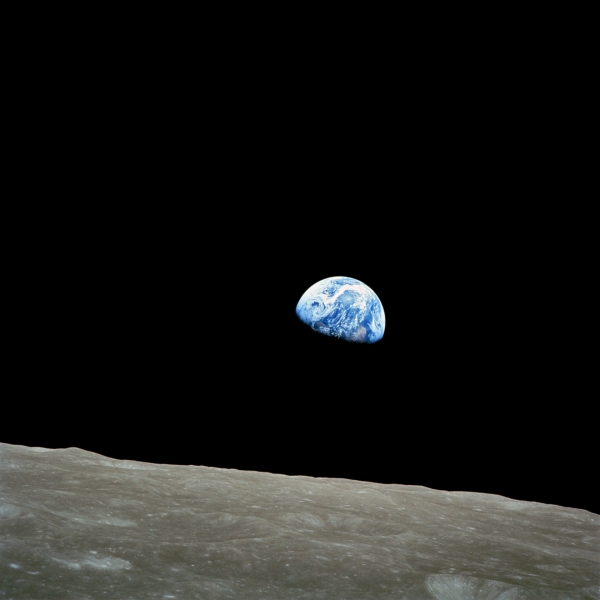Exactly 69 hours, 8 minutes, and 16 seconds after launch, the crew of Apollo 8 burned the spacecraft’s retro rockets while behind the far side of the Moon and out of contact with the Earth. That daring maneuver caused the capsule to enter lunar orbit. The craft circled the Moon three times. After the fourth pass behind the satellite, the three astronauts looked through their tiny glass port and became the first humans to witness an Earthrise.
Lunar Module Pilot William Anders took some photographs of the view in black and white, but he immediately realized the import of what he was seeing and called excitedly for a camera with color film. Command Module Pilot James Lovell passed him the Hasselblad and Anders took one of the most important photographs since the invention of the medium. It was Christmas Eve 1968.
That night 50 years ago, during a television broadcast that was at the time the most viewed in history, Commander Frank Borman announced that the crew had a message for the human race. Then each astronaut read in turn from the Creation Story in the Book of Genesis.
There was a poignancy that can’t be described to today’s interconnected world in hearing that scratchy transmission from a quarter of a million miles away, and the coincidence of the holy date and the tale of a universe coming into existence from nothingness to realize the awe of the harmoniously circling spheres created the perfect message for the first time that humanity had left its home planet.
Then when Apollo 8 returned to Earth and the film was developed, the import of the Earthrise image became apparent, leveraging on the broadcast of the opening verses of the Old Testament. It is safe to say that photograph helped to kick off the environmental era. One year after the lunar mission, Congress passed the National Environmental Policy Act. That same day, December 22, 1969, the Environmental Law Institute opened its doors.
 Capturing the movement created by that photo, the essayist and medical doctor Lewis Thomas wrote about the view in the concluding chapter of his 1974 best seller The Lives of a Cell. The image makes sense of Thomas’s whole book. Lives makes the case that cells are collections of matter that work to perpetuate themselves — absorbing, storing, and using energy — and to produce new generations. Only from the vantage of another celestial body, however, is it apparent that the Earth too is self-perpetuating.
Capturing the movement created by that photo, the essayist and medical doctor Lewis Thomas wrote about the view in the concluding chapter of his 1974 best seller The Lives of a Cell. The image makes sense of Thomas’s whole book. Lives makes the case that cells are collections of matter that work to perpetuate themselves — absorbing, storing, and using energy — and to produce new generations. Only from the vantage of another celestial body, however, is it apparent that the Earth too is self-perpetuating.
“Viewed from the distance of the Moon, the astonishing thing about the Earth, catching the breath, is that it is alive. The photographs show the dry, pounded surface of the Moon in the foreground, dead as an old bone. Aloft, floating free beneath the moist, gleaming membrane of bright blue sky is the rising Earth, the only exuberant thing in this part of the cosmos.”
Thomas notes that “it takes a membrane to make sense out of disorder in biology.” Just as a cell is protected by its membrane, “When the Earth came alive it began constructing its own membrane, for the general purpose of editing the sun.”
It happened in slow stages, as the rocky planet outgassed an atmosphere that proved hospitable for the first photosynthetic cells, which populated the surface with a veneer of green — the first biosphere. These cells produced an oxygen atmosphere with just enough carbon dioxide to cause a congenial greenhouse effect and serve as food for the plants that would later evolve.
In the upper reaches of the membrane, the oxygen is converted by sunlight into ozone, which in turn acts to shield the biosphere producing the oxygen from damaging ultraviolet radiation. Thus, the membrane edits energy to the benefit of the higher life forms that became possible, including of course the first animals and, eventually, environmental professionals.
“We are safe, well-ventilated, and incubated provided we can avoid technologies that might fiddle with that ozone, or shift the levels of carbon dioxide,” Thomas concludes. Chlorofluorocarbons were just becoming known to damage the ozone layer, leading to a phaseout in the 1987 Montreal Protocol. And the theory of climate change as the result of increased greenhouse gases was just getting launched, but within two decades the world had agreed to the 1992 UN climate convention and made more concrete steps in 1997 in Kyoto and 2015 in Paris.
When humanity realized how precious life is on our lonely blue-and-green rock, the reaction kicked off an era of legal interventions to protect the membrane we call the environment. A half century on, we’re still at it.
This blog originally appeared in The Environmental Forum® (Nov.-Dec. 2018) and is reprinted with permission.
